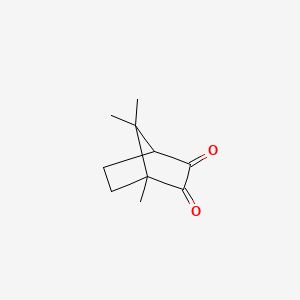| MeSH term | MeSH ID | Detail |
|---|---|---|
| Body Weight | D001835 | 333 associated lipids |
| Dental Leakage | D003763 | 5 associated lipids |
| Hemolysis | D006461 | 131 associated lipids |
Camphorquinone
Camphorquinone is a lipid of Prenol Lipids (PR) class. The involved functions are known as Polymerization. The related lipids are camphoroquinone.
Cross Reference
Introduction
To understand associated biological information of Camphorquinone, we collected biological information of abnormalities, associated pathways, cellular/molecular locations, biological functions, related genes/proteins, lipids and common seen animal/experimental models with organized paragraphs from literatures.
What diseases are associated with Camphorquinone?
There are no associated biomedical information in the current reference collection.
Possible diseases from mapped MeSH terms on references
We collected disease MeSH terms mapped to the references associated with Camphorquinone
PubChem Associated disorders and diseases
What pathways are associated with Camphorquinone
There are no associated biomedical information in the current reference collection.
PubChem Biomolecular Interactions and Pathways
Link to PubChem Biomolecular Interactions and PathwaysWhat cellular locations are associated with Camphorquinone?
There are no associated biomedical information in the current reference collection.
What functions are associated with Camphorquinone?
Related references are published most in these journals:
| Function | Cross reference | Weighted score | Related literatures |
|---|
What lipids are associated with Camphorquinone?
Related references are published most in these journals:
| Lipid concept | Cross reference | Weighted score | Related literatures |
|---|
What genes are associated with Camphorquinone?
There are no associated biomedical information in the current reference collection.
What common seen animal models are associated with Camphorquinone?
There are no associated biomedical information in the current reference collection.
NCBI Entrez Crosslinks
All references with Camphorquinone
Download all related citations| Authors | Title | Published | Journal | PubMed Link |
|---|---|---|---|---|
| Ilie N and Hickel R | Can CQ be completely replaced by alternative initiators in dental adhesives? | 2008 | Dent Mater J | pmid:18540396 |
| Hegde MN et al. | Evaluation of depth of cure and knoop hardness in a dental composite, photo-activated using different methods. | 2008 | J Conserv Dent | pmid:20142889 |
| Cohn CA et al. | Comparison of fluorescence-based techniques for the quantification of particle-induced hydroxyl radicals. | 2008 | Part Fibre Toxicol | pmid:18307787 |
| Hegde MN and Bhandary S | An evaluation and comparison of shear bond strength of composite resin to dentin, using newer dentin bonding agents. | 2008 | J Conserv Dent | pmid:20142888 |
| Pereira SG et al. | Towards a controlled photopolymerization of dental dimethacrylate monomers: EPR studies on effects of dilution, filler loading, storage and aging. | 2008 | J Mater Sci Mater Med | pmid:18415003 |
| Prakki A et al. | Influence of additives on the properties of Bis-GMA/Bis-GMA analog comonomers and corresponding copolymers. | 2007 | Dent Mater | pmid:17178149 |
| Masuki K et al. | Apoptotic and necrotic influence of dental resin polymerization initiators in human gingival fibroblast cultures. | 2007 | Dent Mater J | pmid:18203492 |
| Jeong TS et al. | Effects of LEDs on microhardness and temperature rise of dental composite resins. | 2007 | Dent Mater J | pmid:18203489 |
| de Oliveira MT et al. | Influence of Diamond Sono-Abrasion, Air-Abrasion and Er:YAG Laser Irradiation on Bonding of Different Adhesive Systems to Dentin. | 2007 | Eur J Dent | pmid:19212560 |
| Khalil SK et al. | Use of FT-Raman Spectroscopy to Determine the Degree of Polymerization of Dental Composite Resin Cured with a New Light Source. | 2007 | Eur J Dent | pmid:19212480 |
